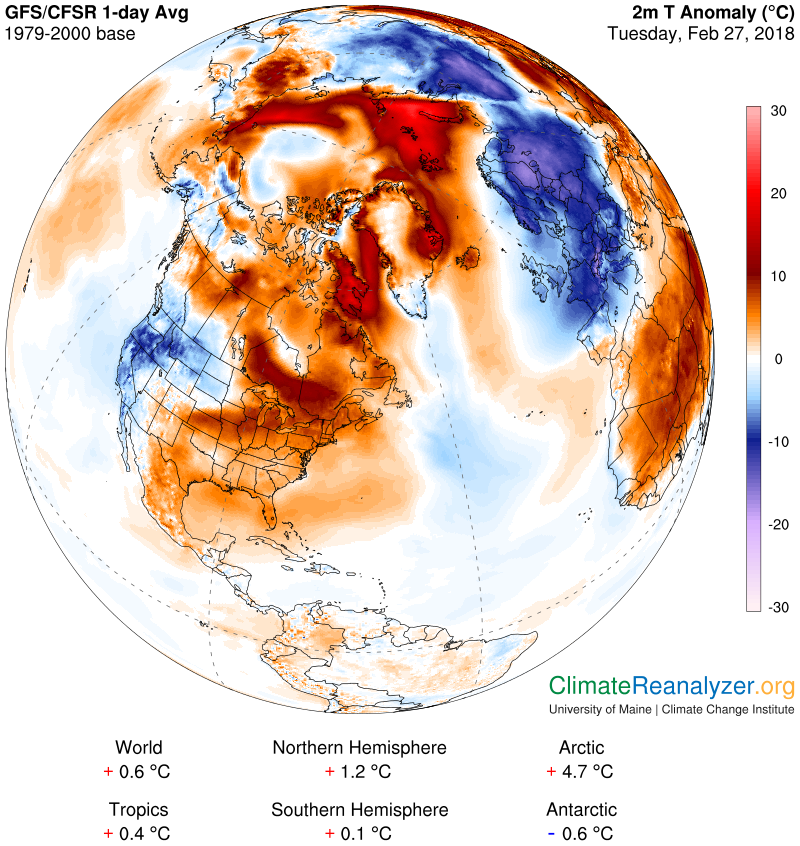Unusually warm temperatures are lingering in much of the Arctic, alarming scientists
At a time when most of the Arctic is in perpetual darkness, temperatures in some places have soared to above freezing.

Last week’s warm Arctic temperatures have lasted into early this week, leaving scientists stunned.
On Tuesday, parts of the Arctic were more than 20 degrees Celsius (36 degrees Fahrenheit) above average temperatures. In northern Greenland, Cape Morris Jesup saw temperatures reaching 43 degrees Fahrenheit over the weekend, even as the science station continues to be shrouded in darkness. The Washington Post reports that temperatures at the North Pole may have reached 35 degrees Fahrenheit.
In 2018, there have already been 61 hours above freezing at Cape Morris Jesup, Greenland.
The previous record was 16 hours before the end of April in 2011. pic.twitter.com/BCgcxAtKng
— Robert Rohde (@rarohde) February 26, 2018
These weather anomalies had various climate and Arctic scientists commenting on Twitter, both over the weekend and early this week.
The recent persistence and widespread coverage of above average temperatures in the #Arctic is particularly noteworthy to me. Map shows the air temperature departure (anomaly) so far this winter (to-date). pic.twitter.com/RgaA6i22NS
— Zack Labe (@ZLabe) February 26, 2018
Speaking to The Atlantic, Zack Labe, a Ph.D. candidate at the University of California, Irvine, said there have been other warming events where Arctic temperatures climbed dramatically above the average. “However, it does appear this particular event featured one of the largest departures on record,” Labe said.
As Discover points out, a recent study found that these dramatic Arctic weather events are becoming more frequent, with each winter seeing an average six more warming events since 1980 — and the events lasting about 12 hours longer on average.
One warm day, week, or year doesn’t mean the planet is warming. But as it warms – which it is – these crazy, head-scratching, whaaaaat?! days, weeks, and years become more and more common. That’s “global weirding”. https://t.co/ZpIZSi3K3k
— Katharine Hayhoe (@KHayhoe) February 26, 2018
These warm events are coupled with a decrease of sea ice in the Arctic, which can impact anything from subsistence hunting seasons to the migration of certain animals. While retreating Arctic sea ice has become common in summer months, it is also happening this winter — a time when sea ice should be accumulating.
The northerly warm airflow opened up the sea ice north of Greenland. This large open water area is very unusual. I haven’t seen a similar event like this before in the almost 25 years I now work with satellite data. pic.twitter.com/RJcONASaO4
— Lars Kaleschke (@seaice_de) February 26, 2018
This lack of sea ice might actually be related to the warming temperatures, as Robert Graham from the Norwegian Polar Institute explained to the Washington Post.
“As the sea ice is melting and thinning, it is becoming more vulnerable to these winter storms,” he wrote in an email to the Washington Post. “The thinner ice drifts more quickly and can break up into smaller pieces. The strong winds from the south can push the ice further north into the Central Arctic, exposing the open water and releasing heat to the atmosphere from the ocean.”